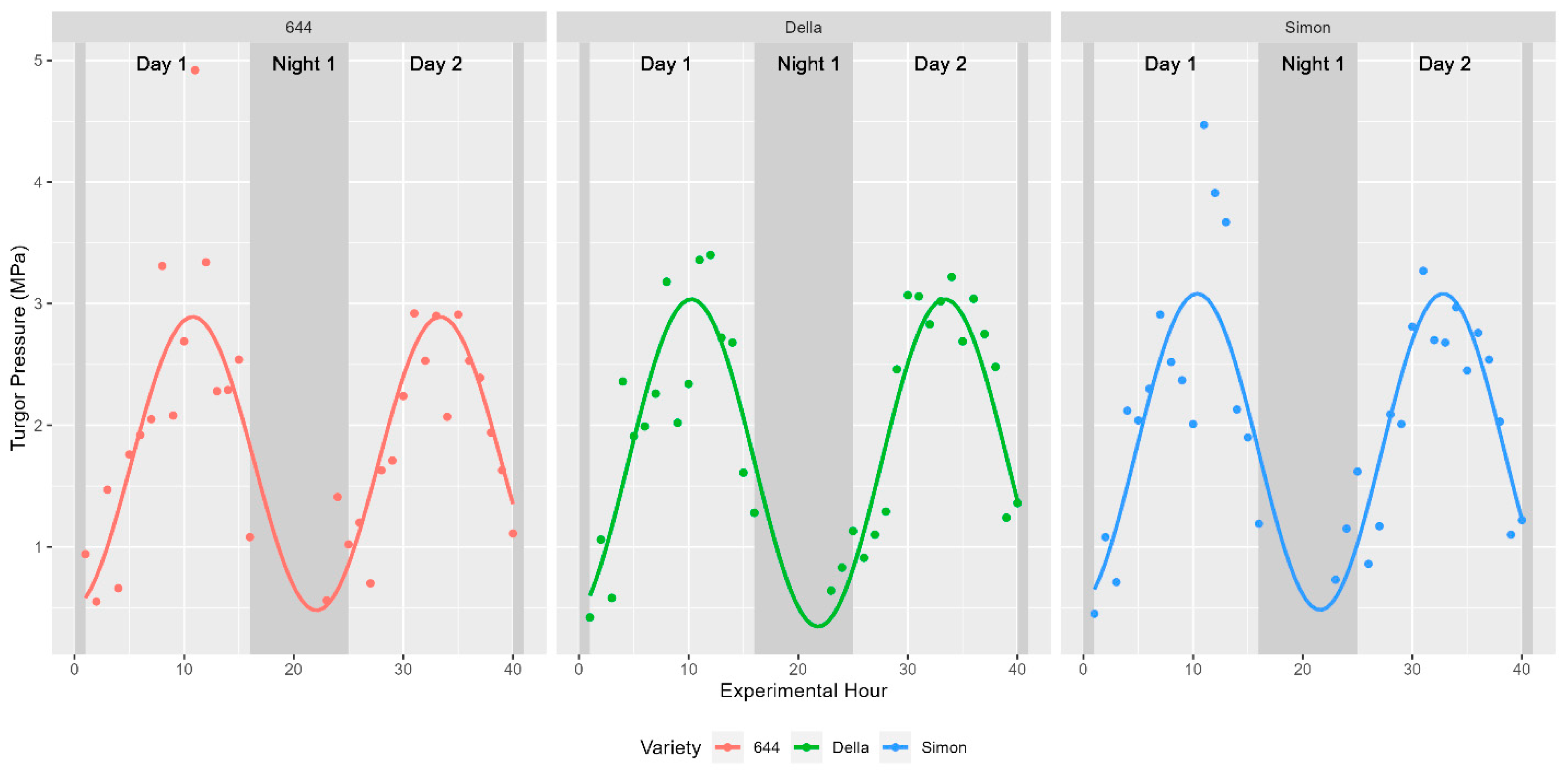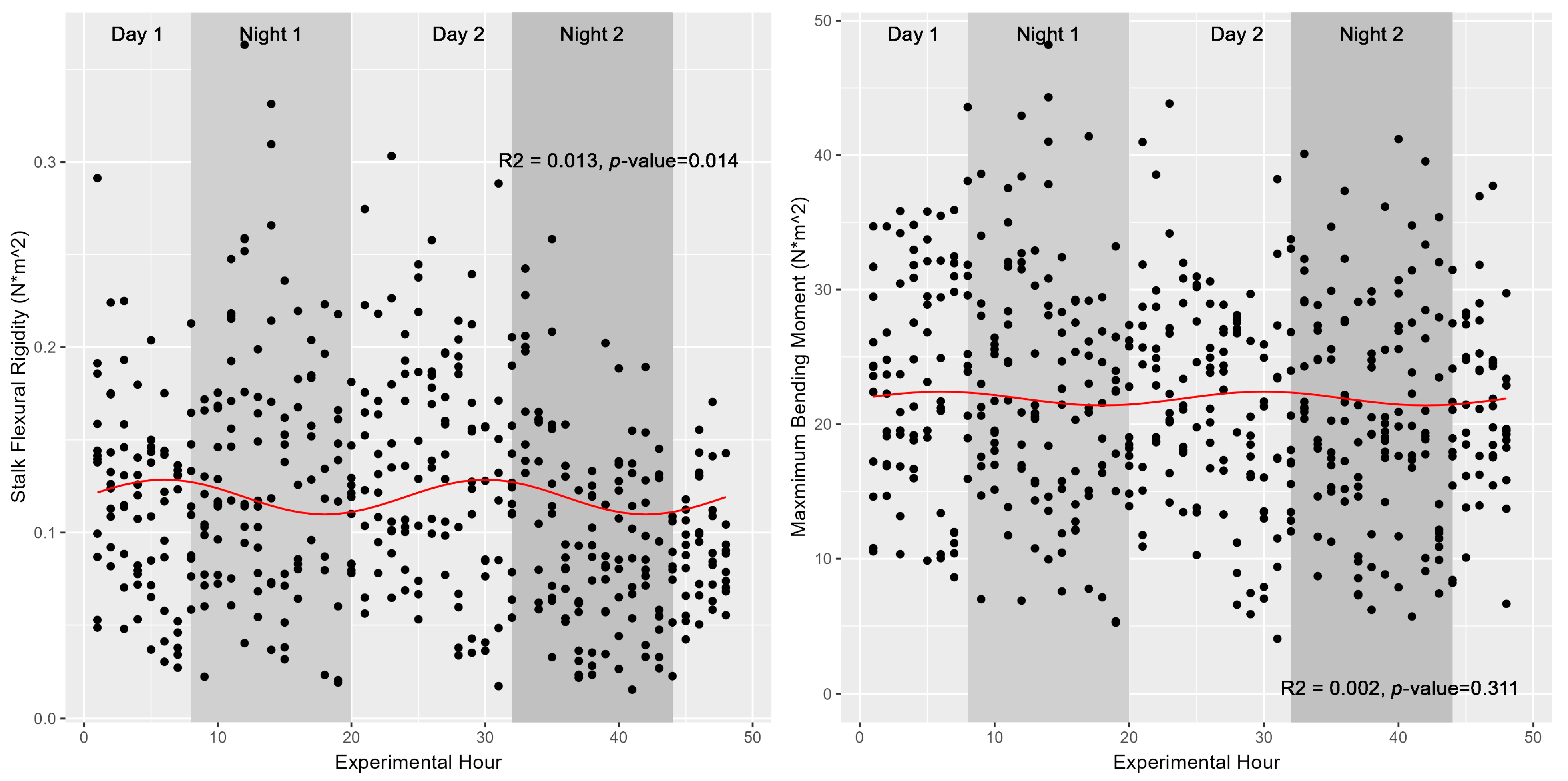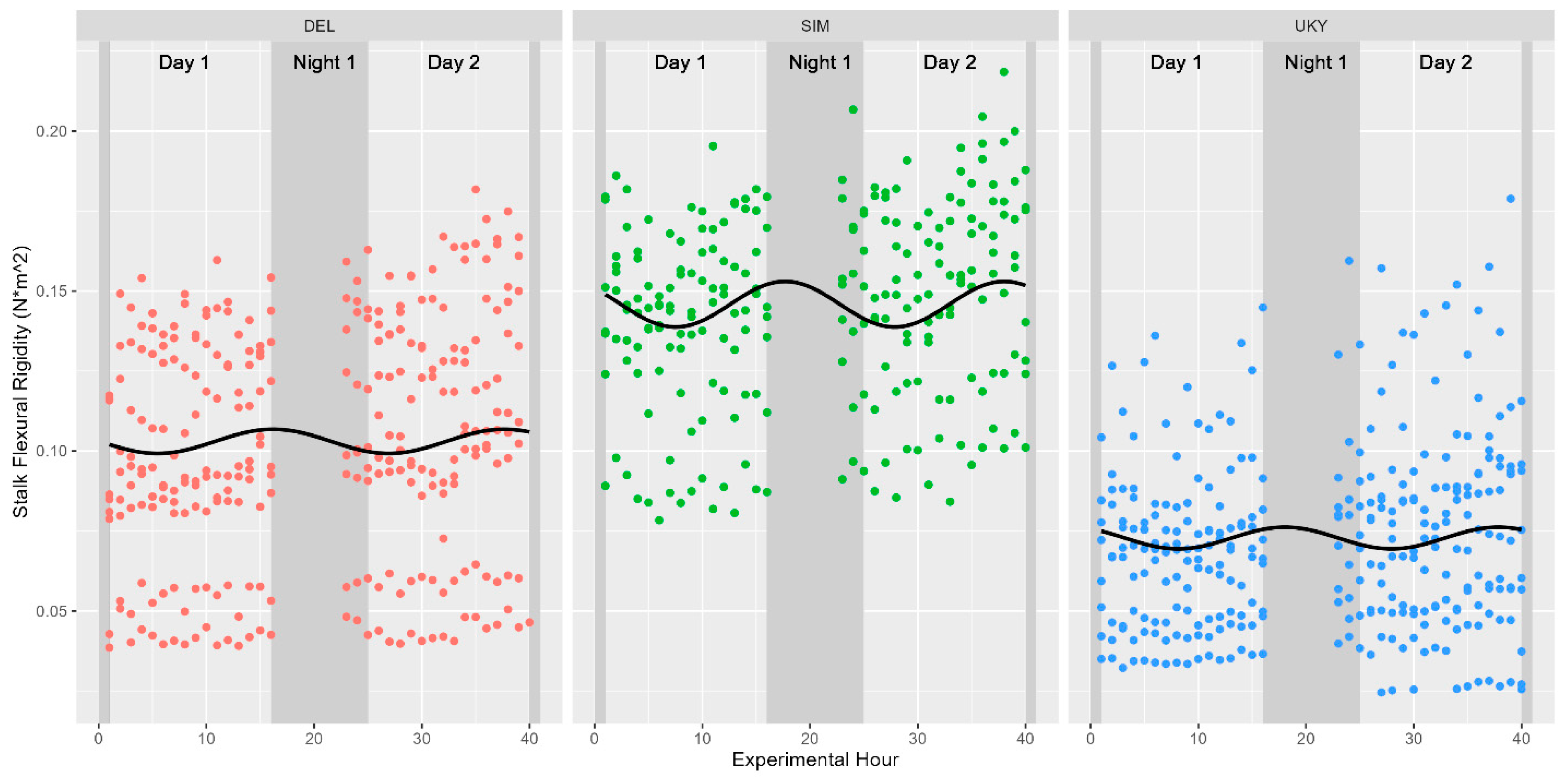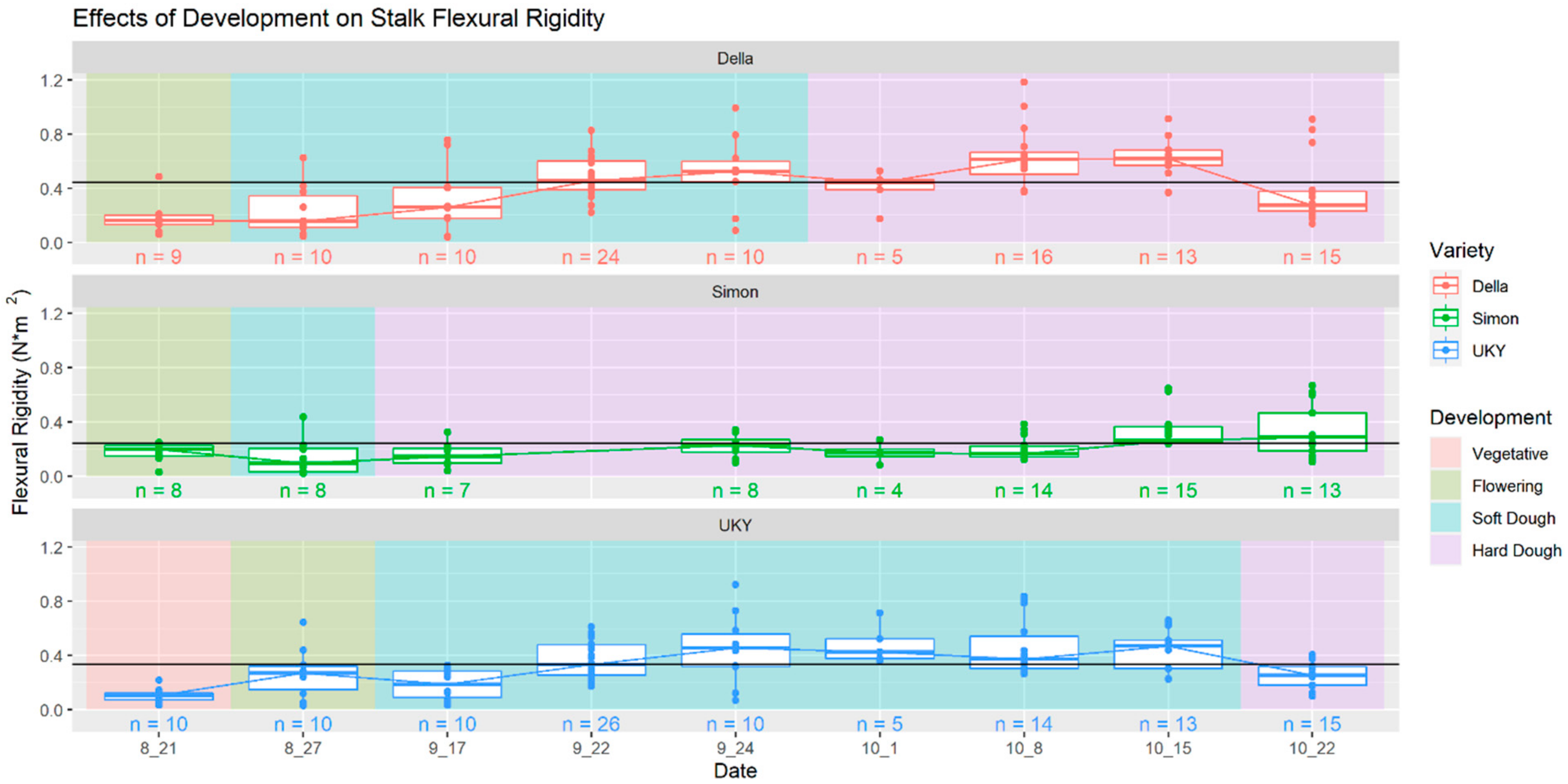Sorghum bicolor L. Stalk Stiffness Is Marginally Affected by Time of Day under Field Conditions
Abstract
1. Introduction
2. Methods
2.1. Plant Material
2.2. Turgor Status Determination
2.3. Strength/Stiffness Measurements
2.4. Morphological and Material Property Phenotype Collection
2.5. Statistical Methods and Analysis
3. Results
3.1. Stalk Phenotypes Are Normally Distributed
3.2. Turgor Pressure Does Fluctuate in a Diurnal Manner
3.3. Neither ToD Nor Turgor Pressure Explain More Than 5% of the Variation in Stalk Flexural Stiffness Measured during Different Times of Day
3.4. Stalk Flexural Stiffness Has the Potential to Be Diminished during Nighttime Hours
3.5. Differences in Flexural Stiffness between Different Developmental Stages Are Significant
3.6. Panicle Weight, ToD, Maximum Bending Moment, and Stalk Density Are Better Linear and Non-Linear Predictors of Stalk Flexural Stiffness
4. Discussion
5. Conclusions
Author Contributions
Funding
Institutional Review Board Statement
Data Availability Statement
Conflicts of Interest
References
- Flint-Garcia, S.A.; Jampatong, C.; Darrah, L.L.; McMullen, M.D. Quantitative Trait Locus Analysis of Stalk Strength in Four Maize Populations. Crop Sci. 2003, 43, 13. [Google Scholar] [CrossRef]
- Kunduru, B.; Kumar, R.; Brar, M.S.; Stubbs, C.J.; Tabaracci, K.; Bokros, N.T.; Bridges, W.C.; Cook, D.D.; DeBolt, S.; McMahan, C.S.; et al. Unveiling the phenotypic landscape of stalk lodging resistance in diverse maize hybrids. Field Crops Res. 2023, 304, 109168. [Google Scholar] [CrossRef]
- Robertson, D.J.; Julias, M.; Lee, S.Y.; Cook, D.D. Maize Stalk Lodging: Morphological Determinants of Stalk Strength. Crop Sci. 2017, 57, 926–934. [Google Scholar] [CrossRef]
- Robertson, D.J.; Julias, M.; Gardunia, B.W.; Barten, T.; Cook, D.D. Corn Stalk Lodging: A Forensic Engineering Approach Provides Insights into Failure Patterns and Mechanisms. Crop Sci. 2015, 55, 2833–2841. [Google Scholar] [CrossRef]
- Stubbs, C.J.; McMahan, C.S.; Tabaracci, K.; Kunduru, B.; Sekhon, R.S.; Robertson, D.J. Cross-sectional geometry predicts failure location in maize stalks. Plant Methods 2022, 18, 56. [Google Scholar] [CrossRef] [PubMed]
- Shah, D.U.; Reynolds, T.P.; Ramage, M.H. The strength of plants: Theory and experimental methods to measure the mechanical properties of stems. J. Exp. Bot. 2017, 68, 4497–4516. [Google Scholar] [CrossRef] [PubMed]
- Beauzamy, L.; Nakayama, N.; Boudaoud, A. Flowers under pressure: Ins and outs of turgor regulation in development. Ann. Bot. 2014, 114, 1517–1533. [Google Scholar] [CrossRef]
- Frensch, J.; Hsiao, T.C. Transient Responses of Cell Turgor and Growth of Maize Roots as Affected by Changes in Water Potential. Plant Physiol. 1994, 104, 247–254. [Google Scholar] [CrossRef] [PubMed]
- Michelena, V.A.; Boyer, J.S. Complete Turgor Maintenance at Low Water Potentials in the Elongating Region of Maize Leaves. Plant Physiol. 1982, 69, 1145–1149. [Google Scholar] [CrossRef]
- Ali, O.; Cheddadi, I.; Landrein, B.; Long, Y. Revisiting the relationship between turgor pressure and plant cell growth. New Phytol. 2023, 238, 62–69. [Google Scholar] [CrossRef] [PubMed]
- Malivert, A.; Erguvan, Ö.; Chevallier, A.; Dehem, A.; Friaud, R.; Liu, M.; Martin, M.; Peyraud, T.; Hamant, O.; Verger, S. FERONIA and microtubules independently contribute to mechanical integrity in the Arabidopsis shoot. PLoS Biol. 2021, 19, e3001454. [Google Scholar] [CrossRef] [PubMed]
- Verger, S.; Long, Y.; Boudaoud, A.; Hamant, O. A tension-adhesion feedback loop in plant epidermis. eLife 2018, 7, e34460. [Google Scholar] [CrossRef] [PubMed]
- Acevedo, E.; Fereres, E.; Hsiao, T.C.; Henderson, D.W. Diurnal Growth Trends, Water Potential, and Osmotic Adjustment of Maize and Sorghum Leaves in the Field. Plant Physiol. 1979, 64, 476–480. [Google Scholar] [CrossRef] [PubMed]
- Pritchard, J.; Tomos, A.D.; Farrar, J.F.; Minchin, P.E.H.; Gould, N.; Paul, M.J.; MacRae, E.A.; Ferrieri, R.A.; Gray, D.W.; Thorpe, M.R. Turgor, solute import and growth in maize roots treated with galactose. Funct. Plant Biol. 2004, 31, 1095. [Google Scholar] [CrossRef] [PubMed]
- Robertson, D.J.; Lee, S.Y.; Julias, M.; Cook, D.D. Maize Stalk Lodging: Flexural Stiffness Predicts Strength. Crop Sci. 2016, 56, 1711–1718. [Google Scholar] [CrossRef]
- Sekhon, R.S.; Joyner, C.N.; Ackerman, A.J.; McMahan, C.S.; Cook, D.D.; Robertson, D.J. Stalk Bending Strength is Strongly Associated with Maize Stalk Lodging Incidence Across Multiple Environments. Field Crops Res. 2020, 249, 107737. [Google Scholar] [CrossRef]
- Erndwein, L.; Cook, D.D.; Robertson, D.J.; Sparks, E.E. Field-based mechanical phenotyping of cereal crops to assess lodging resistance. Appl. Plant Sci. 2020, 8, e11382. [Google Scholar] [CrossRef] [PubMed]
- Reneau, J.W.; Khangura, R.S.; Stager, A.; Erndwein, L.; Weldekidan, T.; Cook, D.D.; Dilkes, B.P.; Sparks, E.E. Maize brace roots provide stalk anchorage. Plant Direct 2020, 4, e00284. [Google Scholar] [CrossRef] [PubMed]
- Paul-Victor, C.; Rowe, N. Effect of mechanical perturbation on the biomechanics, primary growth and secondary tissue development of inflorescence stems of Arabidopsis thaliana. Ann. Bot. 2011, 107, 209–218. [Google Scholar] [CrossRef]
- Blitzer, M.J. AGR-122: Production of Sweet Sorghum for Syrup in Kentucky. Available online: http://www2.ca.uky.edu/agc/pubs/agr/agr122/agr122.pdf (accessed on 21 March 2024).
- Turner, N.C. Techniques and experimental approaches for the measurement of plant water status. Plant Soil. 1981, 58, 339–366. [Google Scholar] [CrossRef]
- Hernández-Hernández, V.; Benítez, M.; Boudaoud, A. Interplay between turgor pressure and plasmodesmata during plant development. J. Exp. Bot. 2019, 71, erz434. [Google Scholar] [CrossRef] [PubMed]
- Cook, D.D.; De La Chapelle, W.; Lin, T.-C.; Lee, S.Y.; Sun, W.; Robertson, D.J. DARLING: A device for assessing resistance to lodging in grain crops. Plant Methods 2019, 15, 102. [Google Scholar] [CrossRef] [PubMed]
- Tabaracci, K.; Bokros, N.; Oduntan, Y.; Kunduru, B.; DeKold, J.; Mengistie, E.; McDonald, A.G.; Stubbs, C.; Sekhon, R.S.; DeBolt, S.; et al. Biomechanical Phenotyping Pipeline for Stalk Lodging Resistance in Maize. MethodsX 2024, 12, 102562. [Google Scholar] [CrossRef] [PubMed]
- Bates, D.; Mächler, M.; Bolker, B.; Walker, S. Fitting Linear Mixed-Effects Models Using lme4. J. Stat. Soft. 2015, 67, 1–48. [Google Scholar] [CrossRef]
- Chen, T.; Guestrin, C. XGBoost: A Scalable Tree Boosting System. In Proceedings of the 22nd ACM SIGKDD International Conference on Knowledge Discovery and Data Mining, San Francisco, CA, USA, 13–17 August 2016; pp. 785–794. Available online: https://dl.acm.org/doi/10.1145/2939672.2939785794 (accessed on 1 March 2024).
- Simmons, L.F. Time-series decomposition using the sinusoidal model. Int. J. Forecast. 1990, 6, 485–495. [Google Scholar] [CrossRef]
- Hale, J.; Webb, S.; Hale, N.; Stubbs, C.; Cook, D. Assessing axial and temporal effects of the leaf sheath on the flexural stiffness of large-grain stems. Crop Sci. 2023, 63, 822–832. [Google Scholar] [CrossRef]
- Stubbs, C.J.; Oduntan, Y.A.; Keep, T.R.; Noble, S.D.; Robertson, D.J. The effect of plant weight on estimations of stalk lodging resistance. Plant Methods 2020, 16, 128. [Google Scholar] [CrossRef] [PubMed]
- Zimmermann, U.; Steudle, E. Physical Aspects of Water Relations of Plant Cells. In Advances in Botanical Research; Elsevier: Amsterdam, The Netherlands, 1979; Volume 6, pp. 45–117. Available online: https://linkinghub.elsevier.com/retrieve/pii/S0065229608603298 (accessed on 12 June 2024)ISBN 978-0-12-005906-5.
- Stubbs, C.J.; Larson, R.; Cook, D.D. Maize stalk stiffness and strength are primarily determined by morphological factors. Sci. Rep. 2022, 12, 720. [Google Scholar] [CrossRef] [PubMed]
- Riboldi, L.B.; Oliveira, R.F.; Angelocci, L.R. Leaf turgor pressure in maize plants under water stress. Aust. J. Crop Sci. 2016, 10, 878–886. [Google Scholar] [CrossRef]
- Murray, S.C.; Rooney, W.L.; Hamblin, M.T.; Mitchell, S.E.; Kresovich, S. Sweet Sorghum Genetic Diversity and Association Mapping for Brix and Height. Plant Genome 2009, 2, 48–62. [Google Scholar] [CrossRef]
- Stubbs, C.J.; Kunduru, B.; Bokros, N.; Verges, V.; Porter, J.; Cook, D.D.; DeBolt, S.; McMahan, C.; Sekhon, R.S.; Robertson, D.J. Moving toward short stature maize: The effect of plant height on maize stalk lodging resistance. Field Crops Res. 2023, 300, 109008. [Google Scholar] [CrossRef]
- Mizuno, H.; Kasuga, S.; Kawahigashi, H. Root lodging is a physical stress that changes gene expression from sucrose accumulation to degradation in sorghum. BMC Plant Biol. 2018, 18, 2. [Google Scholar] [CrossRef] [PubMed]
- Shah, L.; Yahya, M.; Shah, S.M.A.; Nadeem, M.; Ali, A.; Ali, A.; Wang, J.; Riaz, M.W.; Rehman, S.; Wu, W.; et al. Improving Lodging Resistance: Using Wheat and Rice as Classical Examples. Int. J. Mol. Sci. 2019, 20, 4211. [Google Scholar] [CrossRef] [PubMed]
- Yadav, S.; Singh, U.M.; Naik, S.M.; Venkateshwarlu, C.; Ramayya, P.J.; Raman, K.A.; Sandhu, N.; Kumar, A. Molecular Mapping of QTLs Associated with Lodging Resistance in Dry Direct-Seeded Rice (Oryza sativa L.). Front. Plant Sci. 2017, 8, 1431. [Google Scholar] [CrossRef] [PubMed]
- Jin, R.; Li, Z.; Wang, X.; Liu, F.; Kong, F.; Liu, Q.; Lan, T.; Feng, D.; Yuan, J. Optimizing Row Spacing Increases Stalk Lodging Resistance by Improving Light Distribution in Dense Maize Populations. Agronomy 2023, 13, 462. [Google Scholar] [CrossRef]
- Robertson, D.J.; Brenton, Z.W.; Kresovich, S.; Cook, D.D. Maize lodging resistance: Stalk architecture is a stronger predictor of stalk bending strength than chemical composition. Biosyst. Eng. 2022, 219, 124–134. [Google Scholar] [CrossRef]
- DeKold, J.; Robertson, D. Experimental error analysis of biomechanical phenotyping for stalk lodging resistance in maize. Sci. Rep. 2023, 13, 12178. [Google Scholar] [CrossRef] [PubMed]






| Year | Variety | Factor | Sample Size | p-Value | Adj. R2 | Development |
|---|---|---|---|---|---|---|
| 2019 | DEL | Time | 229 | 0.764 | NA | Hard Dough |
| 2019 | 644 | Time | 119 | 0.030 | 0.054 | Hard Dough |
| 2019 | SIM | Time | 514 | 0.014 | 0.010 | Hard Dough |
| 2019 | SIM | Water Potential | 514 | 0.002 | 0.020 | Hard Dough |
| 2020 | DEL | Time | 9 | 0.336 | NA | Flowering |
| 2020 | DEL | Turgor | 9 | 0.494 | NA | Flowering |
| 2020 | 644 | Time | 10 | 0.318 | NA | Vegetative |
| 2020 | 644 | Turgor | 10 | 0.841 | NA | Vegetative |
| 2020 | SIM | Time | 7 | 0.065 | 0.010 | Flowering |
| 2020 | SIM | Turgor | 7 | 0.965 | NA | Flowering |
| Cultivar | ToD | n | Average Flexural Rigidity | p-Value |
|---|---|---|---|---|
| Della | Day | 160 | 0.256 | 0.032 |
| Della | Night | 69 | 0.200 | 0.032 |
| Simon | Day | 229 | 0.122 | 0.277 |
| Simon | Night | 285 | 0.117 | 0.277 |
| 644 | Day | 69 | 0.189 | 0.976 |
| 644 | Night | 50 | 0.187 | 0.976 |
| Feature | p-Value | Adj. R2 |
|---|---|---|
| Stalk Water Content | 0.710 | NA |
| Brix (%) | 0.622 | NA |
| Maximum Angle | 0.486 | NA |
| Leaf Water Potential | 0.318 | 0 |
| ToD | 0.014 | 0.011 |
| Panicle Weight | 0 | 0.152 |
| Maximum Bending Moment | 0 | 0.739 |
| Stalk Dry Weight | 0 | 0.165 |
| Feature | Gain | Cover | Frequency | Importance |
|---|---|---|---|---|
| Maximum Bending Moment | 0.746 | 0.243 | 0.214 | 0.746 |
| ToD | 0.060 | 0.084 | 0.102 | 0.060 |
| Panicle Weight | 0.052 | 0.106 | 0.131 | 0.052 |
| Leaf Water Potential | 0.047 | 0.143 | 0.120 | 0.047 |
| Maximum Angle | 0.039 | 0.137 | 0.134 | 0.039 |
| Stalk Dry Weight | 0.003 | 0.082 | 0.102 | 0.027 |
| Stalk Water Content | 0.025 | 0.152 | 0.154 | 0.025 |
| Brix (%) | 0.004 | 0.053 | 0.043 | 0.004 |
Disclaimer/Publisher’s Note: The statements, opinions and data contained in all publications are solely those of the individual author(s) and contributor(s) and not of MDPI and/or the editor(s). MDPI and/or the editor(s) disclaim responsibility for any injury to people or property resulting from any ideas, methods, instructions or products referred to in the content. |
© 2024 by the authors. Licensee MDPI, Basel, Switzerland. This article is an open access article distributed under the terms and conditions of the Creative Commons Attribution (CC BY) license (https://creativecommons.org/licenses/by/4.0/).
Share and Cite
Bokros, N.; Woomer, J.; Schroeder, Z.; Kunduru, B.; Brar, M.S.; Seegmiller, W.; Stork, J.; McMahan, C.; Robertson, D.J.; Sekhon, R.S.; et al. Sorghum bicolor L. Stalk Stiffness Is Marginally Affected by Time of Day under Field Conditions. Agriculture 2024, 14, 935. https://doi.org/10.3390/agriculture14060935
Bokros N, Woomer J, Schroeder Z, Kunduru B, Brar MS, Seegmiller W, Stork J, McMahan C, Robertson DJ, Sekhon RS, et al. Sorghum bicolor L. Stalk Stiffness Is Marginally Affected by Time of Day under Field Conditions. Agriculture. 2024; 14(6):935. https://doi.org/10.3390/agriculture14060935
Chicago/Turabian StyleBokros, Norbert, Joseph Woomer, Zoe Schroeder, Bharath Kunduru, Manwinder S. Brar, Will Seegmiller, Jozsef Stork, Christopher McMahan, Daniel J. Robertson, Rajandeep S. Sekhon, and et al. 2024. "Sorghum bicolor L. Stalk Stiffness Is Marginally Affected by Time of Day under Field Conditions" Agriculture 14, no. 6: 935. https://doi.org/10.3390/agriculture14060935
APA StyleBokros, N., Woomer, J., Schroeder, Z., Kunduru, B., Brar, M. S., Seegmiller, W., Stork, J., McMahan, C., Robertson, D. J., Sekhon, R. S., & DeBolt, S. (2024). Sorghum bicolor L. Stalk Stiffness Is Marginally Affected by Time of Day under Field Conditions. Agriculture, 14(6), 935. https://doi.org/10.3390/agriculture14060935






